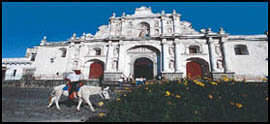 TRAVELING ABOUT TRAVELING ABOUT |

If driving, riding, biking, or walking is on your agenda, you are sure to see how well the transportation infrastructure is in Guatemala. Most roads are well maintained and those to major points of interest are being repaved and improved.
A new toll highway from Guatemala City to the Pacific coast has been opened and has multiple lanes in both directions. In the capital city of Guatemala, a number of improvements have been made. Two new underpasses have been constructed to help ease the flow of traffic. New signs, improved lighting and repaving have been done in the capital city. The road to Petén and Tikal used to be the exception. The governments roadworks department has taken the matter to heart, and has completely paved the highway. If you want to avoid many hours on the road, then take one of the daily commuter flights available to the area.
The Pan American highway traverses Guatemala from the Mexican border in the northwest to El Salvador in the southeast. It is well maintained and is safe to use. Always be on the lookout for falling rocks, pot holes and mudslides, especially during the rainy season. Because of the volcanic topography, there are many mountains and winding roads, so be on the lookout for passing cars and buses. The curves can be dangerous due to being sharp and narrow.
The government has made a concerted effort to add new road signs for directions, as well as for dangerous curves and other precautionary signals. There are many steep grades due to the mountainous topography so breaking with your motor (frene con motor) is wise when descending a steep mountain road. Always be well prepared and pack accordingly. Fresh water, food, tools and other necessities are indispensable for emergency packs. Road maps may be obtained at the Guatemalan Tourism Institute in Zone 4 of Guatemala City. Car rental agencies, and some hotels also offer them. |  Rental Cars Rental Cars |
Rental car agencies are plentiful. All have late model vehicles that range from subcompact to four-wheel drive vehicles. Prices are competitive and service is usually very good.
 Airlines Airlines |
Countrywide service is available to most areas. Local airlines are now servicing outlying areas on a daily basis. Daily flights to Petén and Tikal are available through various airlines. International service is good and timely. Confirm your flight 24 hours in advance.
 Public Transportation Public Transportation |
The public transit system in Guatemala reaches even the most outlying towns in the country. While the buses may not be visually appealing, it is the standard form of transportation for the majority of the population. The system is timely and reliable.
 Boat Service Boat Service |
There are ferry services that cross Lake Atitlán daily. They will take you to many of the towns that dot the shoreline of the lake. There are also services available in the Lake Izabal and Río Dulce area.
 Road Tips Road Tips |
If you come upon a tree branch in the middle of the lane, there is most often a disable vehicle ahead.
When approaching a tight curve, sound your horn to warn oncoming traffic.
Police check points are common. Make sure your car's documents and driver's license are easily accessible.
The vehicle going up a hill has the right of way.
Watch out for speed bumps (tumulos). They are sometimes found in the most peculiar places.
All these informations are provided by courtesy of Destination Guatemala and Sol y Luna |

